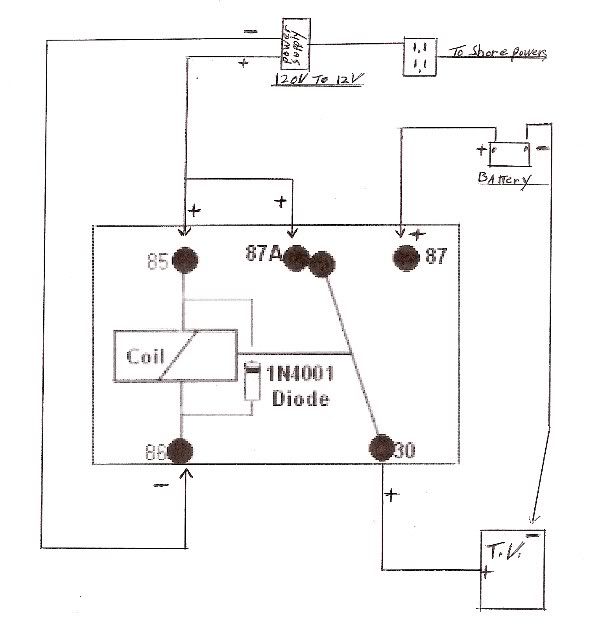Using an inverter may well be the route I take...but if I can find a way to make the switching automatic, then why not.
If we really want to jump into the "safe" zone, then unplugging the television from battery power, and connecting the factory supplied power source to a 120V outlet when hooked to shore power is pretty failsafe.
At least until I forget to unplug from battery power before I hook to shore power...
Running an inverter may be even safer, but it also means accepting a small power loss (capacity) as well as having to buy another device.
Thus far, the relay is cheaper.
Even if this whole excercise is for not, I've enjoyed the challenge of trying, and of learning something new.
That it is the most efficient, or easiest does not matter, it is a challenge.
I don't understand the need for a 120V relay.
Unless I missed something, the relay won't be energized when running on the battery, as it will need the power supply to energize the coil, to pull the contact over to the power supply?
I guess I'm making a big assumption here, but it seems as though when the coil is energized, it "pulls" the contact from #87 to #87A.
Meaning that the power flow from #87 to #30 is uninterrupted until shore power is connected.
But perhaps I've confused everyone with my many posts (something I'm pretty good at) so, let me try again.
The television came with a power source.
It is 120V to 12.5V
I have the tv hooked up to the battery bank.
If I use the relay in the diagram below, power (+) is routed from the battery to #87, then through the relay to #30, which feeds the tv.
The negative cable completes the circuit.

Now, when shore power is available, as soon as it is energized, 12.5V from the power supply will energize the coil, and # 87A, pulling the "switch" which will disconnect the battery lead, and allow power to flow from 87A to 30.
However, there is not a complete circuit because the negative battery terminal, and the negative power supply terminal are not connected.
Do I need to also connect the negative from #86 to the television, and if so, does it not cause problems having the power source (-) connected to the battery through the tv?
Rob
Waiting for "someday" will leave you on your deathbed wondering why you didn't just rearrange your priorities and enjoy the time you had, instead of waiting for a "better" time to come along...






 If we want to get that deep I guess I will have to get out the Fluke and get the exact measurements. ( I was generalizing ) I myself am running a 375 amp battery bank, so the loss is not really a big concern. I can even run my A/C off battery if needed. and actually plan to do so, my Genset isn't large enough to handle the Compressor spikes but is large enough to provide the amperage required and I will let the battery's handle them while the genset provides the constant power to the power converter.
If we want to get that deep I guess I will have to get out the Fluke and get the exact measurements. ( I was generalizing ) I myself am running a 375 amp battery bank, so the loss is not really a big concern. I can even run my A/C off battery if needed. and actually plan to do so, my Genset isn't large enough to handle the Compressor spikes but is large enough to provide the amperage required and I will let the battery's handle them while the genset provides the constant power to the power converter.

 George is the man He's the first one I'd ask for advice.
George is the man He's the first one I'd ask for advice. 
